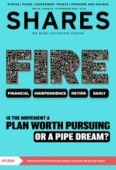Archived article
Please note that tax, investment, pension and ISA rules can change and the information and any views contained in this article may now be inaccurate.
Luxury goliath LVMH shows resilience but Diageo serves up sobering results

Post-Christmas updates from the industry demonstrate that not all luxury goods companies are created equal, with sector players experiencing contrasting fortunes as the post-pandemic boom normalises and well-heeled shoppers prove more selective.
On 25 January, the world’s largest luxury goods group LVMH (MC:EPA) confounded investors’ gloomy expectations by delivering better-than-expected fourth quarter organic sales growth of 10%. This reassured investors about the sector’s resilience and triggered a rally in the shares, dragging rivals Hermes (RMS:EPA), Richemont (CFR:SWX) and Burberry (BRBY) up in sympathy.
LVMH’s Q4 growth rate represented an improvement on the 9% growth seen in the third quarter amid resilient demand for the conglomerate’s high-end products over Christmas, although growth for 2023 as a whole slowed versus 2022.
Controlled by French billionaire Bernard Arnault, LVMH is diversified across multiple higher positioned brands including Louis Vuitton, Christian Dior, Givenchy, Tiffany, TAG Heuer and Hennessy cognac, which spark desire among its well-heeled clientele.
In contrast, rainwear-to-leather goods seller Burberry is a mono-brand business which issued a post-Christmas profit warning (12 January) amid ongoing sales deceleration, while Watches of Switzerland (WOSG), the high-end timepieces and jewellery-focused firm, also downgraded guidance after a disappointing Christmas.
Premium drinks companies such as Diageo (DGE) and spirits rival Pernod Ricard (RI:EPA) offer exposure to similar themes as the luxury sector, but their gross margins are lower and they appear less immune to economic downswings than ‘genuine’ luxury companies of which LVMH is the perfect exemplar.
Johnnie Walker-to-Smirnoff maker Diageo’s first half results (30 January) missed expectations at the top and bottom line amid weak sales in the Americas to leave question marks hanging over its true luxury credentials as consumers feel the squeeze.
Net sales dropped 1.4% to $11 billion in the six months to 31 December 2023, primarily driven by a 23% drop in Latin America and Caribbean sales driven by customers trading down to cheaper alternatives which triggered November’s profit warning.
Diageo’s sales in North America were down 1.5% as it maintained its focus on pricing and margins in order to drive what it calls ‘high-quality share growth’ in its largest region. 2024 is likely to be tough for the drinks giant, which guided to a year-on-year organic operating profit decline expected for the second half, although Diageo does foresee a gradual improvement in its organic sales growth rate in the second half.
Important information:
These articles are provided by Shares magazine which is published by AJ Bell Media, a part of AJ Bell. Shares is not written by AJ Bell.
Shares is provided for your general information and use and is not a personal recommendation to invest. It is not intended to be relied upon by you in making or not making any investment decisions. The investments referred to in these articles will not be suitable for all investors. If in doubt please seek appropriate independent financial advice.
Investors acting on the information in these articles do so at their own risk and AJ Bell Media and its staff do not accept liability for losses suffered by investors as a result of their investment decisions.
Issue contents
Daniel Coatsworth
Editor's View
Education
Feature
Great Ideas
Investment Trusts
News
- Pfizer beats earnings expectations but still has a lot to do to recapture former glories
- Chinese stock market rocked by $330 billion Evergrande liquidation
- Why shares in fashion victim Superdry have slumped 50% year-to-date
- InterContinental Hotels continues to benefit from strong travel demand
- Luxury goliath LVMH shows resilience but Diageo serves up sobering results

 magazine
magazine








